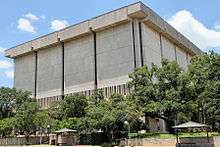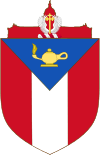Harry Ransom Center

The Harry Ransom Center is an archive, library and museum at the University of Texas at Austin, specializing in the collection of literary and cultural artifacts from the United States and Europe for the purpose of advancing the study of the arts and humanities. The Ransom Center houses 36 million literary manuscripts, 1 million rare books, 5 million photographs, and more than 100,000 works of art. The Center has a reading room for scholars and galleries which display rotating exhibitions of works and objects from the collections.
Notable possessions
The two most prominent possessions in the Ransom Center's collections are a Gutenberg Bible[1][2] (one of only 21 complete copies known to exist) and Nicéphore Niépce's View from the Window at Le Gras, the first successful permanent photograph from nature. Both of these objects are on permanent display in the main lobby.
Beyond these, the Center houses many culturally important documents and artifacts. Particular strengths include modern literature, performing arts,[3] and photography.[4] Besides the Gutenberg Bible and the photograph, notable holdings include:
Literature
- Three copies of the First Folio of William Shakespeare's plays
- A suppressed first edition of Alice's Adventures in Wonderland, one of only 23 copies known to exist.
- The first edition of the book Os Lusíadas, printed in 1572.
- The personal libraries of writers such as Ezra Pound, Evelyn Waugh, Alice Corbin Henderson, Gabriel Garcia Marquez, and the Coleridge family
- Extensive manuscript collections of Lewis Carroll, Doris Lessing, Aleister Crowley, James Joyce, T. E. Lawrence, D. H. Lawrence, T.H. White, Carson McCullers, Norman Mailer, Anne Sexton, Don DeLillo, Graham Greene, Brian Moore, Erle Stanley Gardner, David Foster Wallace, Julian Barnes, and Ian McEwan.
- Edgar Allan Poe's writing desk
- A large collection of rare and valuable comic books
- A writing journal kept by Jack Kerouac in preparation for writing On the Road
- The Cardigan manuscript of Chaucer's Canterbury Tales
- The rare original first edition of Liber Al (among other original Crowley First Editions), also known as the Vellum books but more popularly known as the Holy Book of Thelema by Aleister Crowley.
- Tarot cards hand-colored by Aleister Crowley
History
- A 16th-century globe designed by Gerardus Mercator
- Kraus Map Collection, a 16th- and 17th-century cartographic collection
- An official declaration by Napoleon Bonaparte
- The love letters of the Mexican Emperor Maximilian I and his wife Carlota
- Bob Woodward and Carl Bernstein's notes, interviews, manuscripts, and other documents relating to the Watergate scandal
Theatre and film
- The papers of Stella Adler, Robert De Niro, David Mamet, Arthur Miller, David O. Selznick, George Bernard Shaw, Tom Stoppard, Gloria Swanson, Tennessee Williams, Harry Houdini and Spalding Gray
- Selected costumes, script drafts, storyboards, and audition tapes from Gone with the Wind. These are part of the David O. Selznick Collection
- Unused props designed by Salvador Dalí to have been used in the dream sequence in Spellbound
- The sunglasses worn by Gloria Swanson in Sunset Boulevard
Art
- Two paintings by Frida Kahlo: Self Portrait with Thorn Necklace and Hummingbird and Still Life (with Parrot and Fruit)
- A complete set of Picasso's Vollard Suite
- A she-wolf statue carved in stone and coated with gold leaf (now worn off) by Eric Gill, creator of Gill Sans
- Busts of various writers (on display in the lobby and reading room)
- Large holdings in art by writers and portraits of literary figures
- Facsimile of the piano suite Gaspard de la nuit composed by Maurice Ravel
History of the Center
Harry Ransom founded the Humanities Research Center in 1957 with the ambition of expanding the rare books and manuscript holdings of the University of Texas. He acquired the Edward Alexander Parsons Collection,[5] the T. Edward Hanley Collection,[6] and the Norman Bel Geddes Collection.[7][8]
Ransom himself was the official director of the Center for only the years 1958 to 1961, but he directed and presided over a period of great expansion in the collections until his resignation in 1971 as Chancellor of the University of Texas System. The Center moved into its current building in 1972.
F. Warren Roberts was the official director from 1961 to 1976 and acquired the Helmut Gernsheim Collection of photographs, the archives of D. H. Lawrence, John Steinbeck, and Evelyn Waugh, and in 1968 the Carlton Lake Collection.[9]
After Roberts's tenure, John Payne and then Carlton Lake served as interim directors from 1976 to 1980. It was during this time (in 1978) that the Center acquired its complete copy of the Gutenberg Bible.
In 1980, the Center hired Decherd Turner as director. Turner acquired the Giorgio Uzielli Collection of Aldine editions,[10] the Anne Sexton archive, the Robert Lee Wolff Collection of 19th-century fiction, the Pforzheimer Collection,[11] the David O. Selznick archive, the Gloria Swanson archive, and the Ernest Lehman Collection.[12] Upon Decherd Turner's retirement in 1988, Thomas F. Staley became director of the Center.[13] Staley has acquired the Woodward and Bernstein Watergate Papers,[14] a copy of the Plantin Polyglot Bible, and more than 100 literary archives. In September 2013, Stephen Enniss was appointed director of the Ransom Center. Enniss was formerly the Head Librarian of the Folger Shakespeare Library.[15]
See also
- Thomas James Wise His personal papers — consisting of 33 document boxes (13.86 linear feet), and 2 galley folders — are at the Harry Ransom Center of The University of Texas at Austin. They are housed off site and require advance requests for examination.[16]
References
- ↑ Gutenberg Bible, permanent exhibit at HRC
- ↑ Luxist.com: The World of Rare Books: The Gutenberg Bible, First and Most Valuable
- ↑ Performing Arts - Harry Ransom Center
- ↑ Photography - Harry Ransom Center
- ↑ Edward Alexander Parsons Collection
- ↑ T. Edward Hanley Library
- ↑ Normal Bel Geddes Theater and Industrial Design Papers
- ↑ Lewis, Anne S. (September 10, 2012). "Normal Bel Geddes, Harry Ransom Center, Future Perfect exhibition". Wall Street Journal.
- ↑ Carlton Lake brief bio from "New Directions" Carlton Lake (1915–2006) was the Paris art critic for the Christian Science Monitor.
- ↑ Aldine Press Giorgio Uzielli was a New York stockbroker and book collector, born in Florence, Italy. After a 1982 visit to the Harry Ransom Center, he wrote into his will a bequest to the Center of his 287 books printed by the Aldine Press in Venice in the 15th and 16th centuries. Uzielli's gift was appraised at about $2 million.
- ↑ Carl H. Pforzheimer Library
- ↑ Ernest Lehman Collection
- ↑ Director Thomas F. Staley: Major Acquisitions and Achievements
- ↑ Woodward and Bernstein Watergate Papers
- ↑ "Stephen Enniss appointed new director of Ransom Center", Harry Ransom Center.
- ↑ "Thomas James Wise: An Inventory of His Collection at the Harry Ransom Center" (PDF). The University of Texas at Austin, Harry Ransom Center. Retrieved February 11, 2014.
Sources
- Max, D. T. (June 11, 2007). "Letter from Austin: Final Destination". The New Yorker. Retrieved 2007-06-20.
- Pearson, Rachel (March 7, 2006). "Center offers literary sort of Ransom". The Daily Texan. Retrieved 2006-03-17.
- Pearson, Rachel (March 8, 2006). "Ransom Center criticized abroad". The Daily Texan. Retrieved 2006-03-17.
- Page, Caroline (October 30, 2007). "HRC holds cultural gems". The Daily Texan. Retrieved 2007-10-30.
- Page, Caroline (November 7, 2007). "Ransom Center home to De Niro collection and other rare works". The Daily Texan. Retrieved 2007-11-19.
- Page, Caroline (November 15, 2007). "Ransom Center leads in conservation". The Daily Texan. Retrieved 2007-11-19.
- Page, Caroline (December 4, 2007). "Literary treasure hunt". The Daily Texan. Retrieved 2007-12-04.
- "Harry Ransom Center Acquires Rare Plantin Polyglot Bible". April 29, 2008. Retrieved 2008-05-01.
External links
| Wikimedia Commons has media related to Harry Ransom Center. |
- Official website
- Why do the archives of so many great writers end up in Texas?, The New Yorker, June 11, 2007
Coordinates: 30°17′03″N 97°44′28″W / 30.2843°N 97.7412°W

